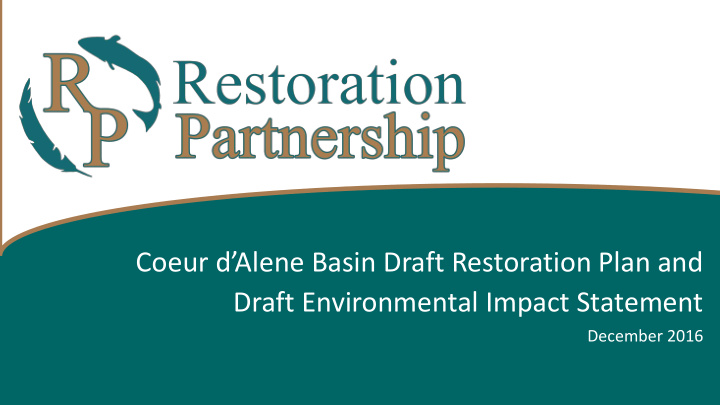



Coeur d’Alene Basin Draft Restoration Plan and Draft Environmental Impact Statement December 2016
Restoration Partnership Natural Resource Trustees / Trustee Council U.S. Dept. of Interior U.S. Dept. of Agriculture Coeur d’ Alene Tribe State of Idaho Representative Agencies Restoration Team: Rebecca Stevens (CdA Tribe), Tim Kiser (USFWS), Jo Christensen (USFS), Dave Leptich (IDFG), Kajsa Van de Riet (DEQ) Caj Matheson – Communications Specialist
Background • Historic releases of mine wastes • Widespread metals contamination • Injuries to natural resources and loss of associated services they provide • Lawsuits and settlements
Background • Restoration plan required • 2007 Interim Plan • National Environmental Policy Act (NEPA) process • Public Scoping 2013 • Development of draft restoration plan & environmental impact statement • Public comment
Draft Restoration Plan • Programmatic • Focus on wetlands, streams, and lakes habitats • Includes human uses • Identifies the goal, major actions, strategies & techniques for each section • Identifies geographic priorities
Approach and Values • Link to Injured Resources • Coeur d’Alene Basin Focus • Priority in Contaminated Areas • Emphasis on Ecosystem Processes • Habitat Focus and Focal Resources • Best Available Science • Cultural Focus • Engagement with Stakeholders • Economic Resilience
Approach and Values • Integration • Cost Effectiveness • Timing and rate of restoration • Monitoring and Adaptive Restoration • Hierarchy of Preferred Restoration Approaches • Types of Restoration Not Desired
Draft Plan & Environmental Impact Statement • Draft Environmental Impact Statement (DEIS) o Compares the effects of doing nothing to active restoration o Compares the effects of two alternative approaches to restoration
Planning Area
Alternatives Alternative 1 Alternative 2 Alternative 3 No Action Ecosystem Focus + Ecosystem Additional Human Restoration Focus Use Considerations (Preferred)
Programmatic • Draft plan does not include specific projects or sites • Framework of approaches and priorities • Solicitation and selection of projects
Wetlands • Geographic priorities guided by needs of waterfowl (bird use and degree of contamination)
Streams • Geographic priorities guided by needs of native trout (westslope cutthroat trout and bull trout)
Lakes • Geographic priorities guided by needs of waterfowl and native trout • Coeur d’Alene Lake complex top priority
Human Uses • Geographic priorities guided by public input • Limited funding amount • Must be related to injured natural resources
Public Comment • Draft Plan and DEIS available at www.restorationpartnership.org • Hard copies available at offices • Seeking substantive comments • By mail, email, or online form • Comments due by January 13, 2017
Next Steps • Respond to public comments • Finalize plan and EIS • Issue and adopt a Record of Decision (ROD) • Begin restoration • Timing depends on comments
www.restorationpartnership.org
Geographic Prioritization
Recommend
More recommend